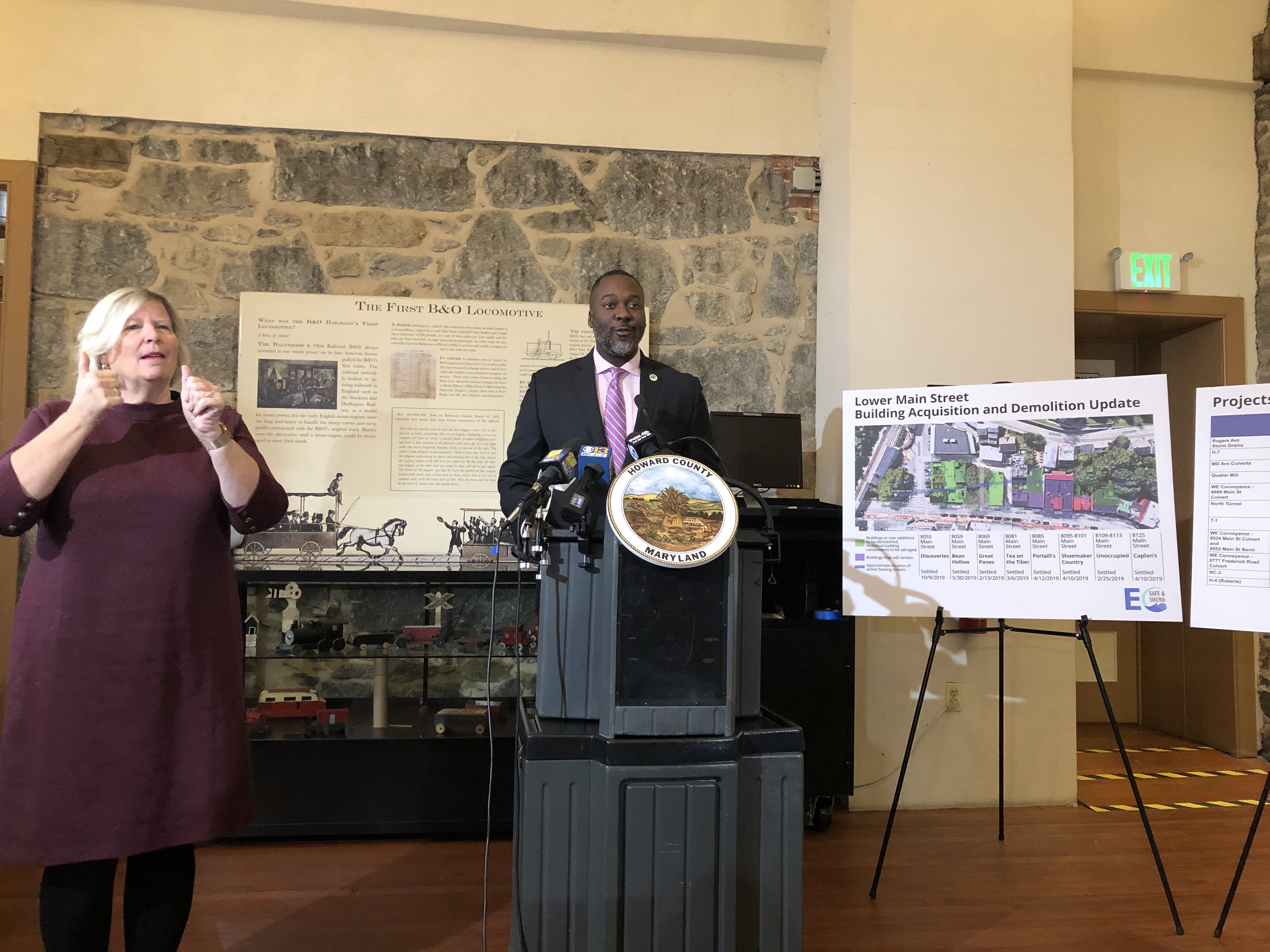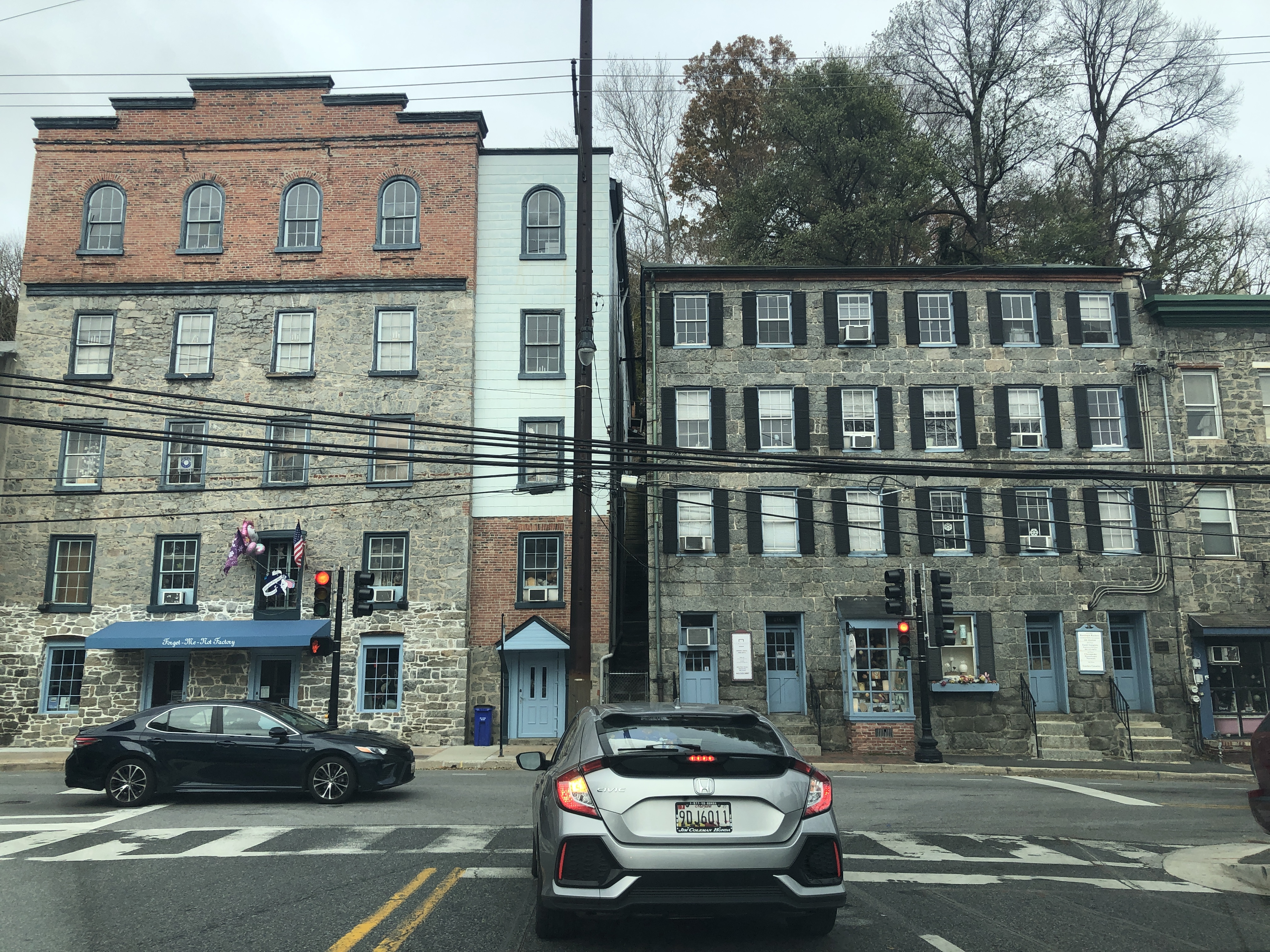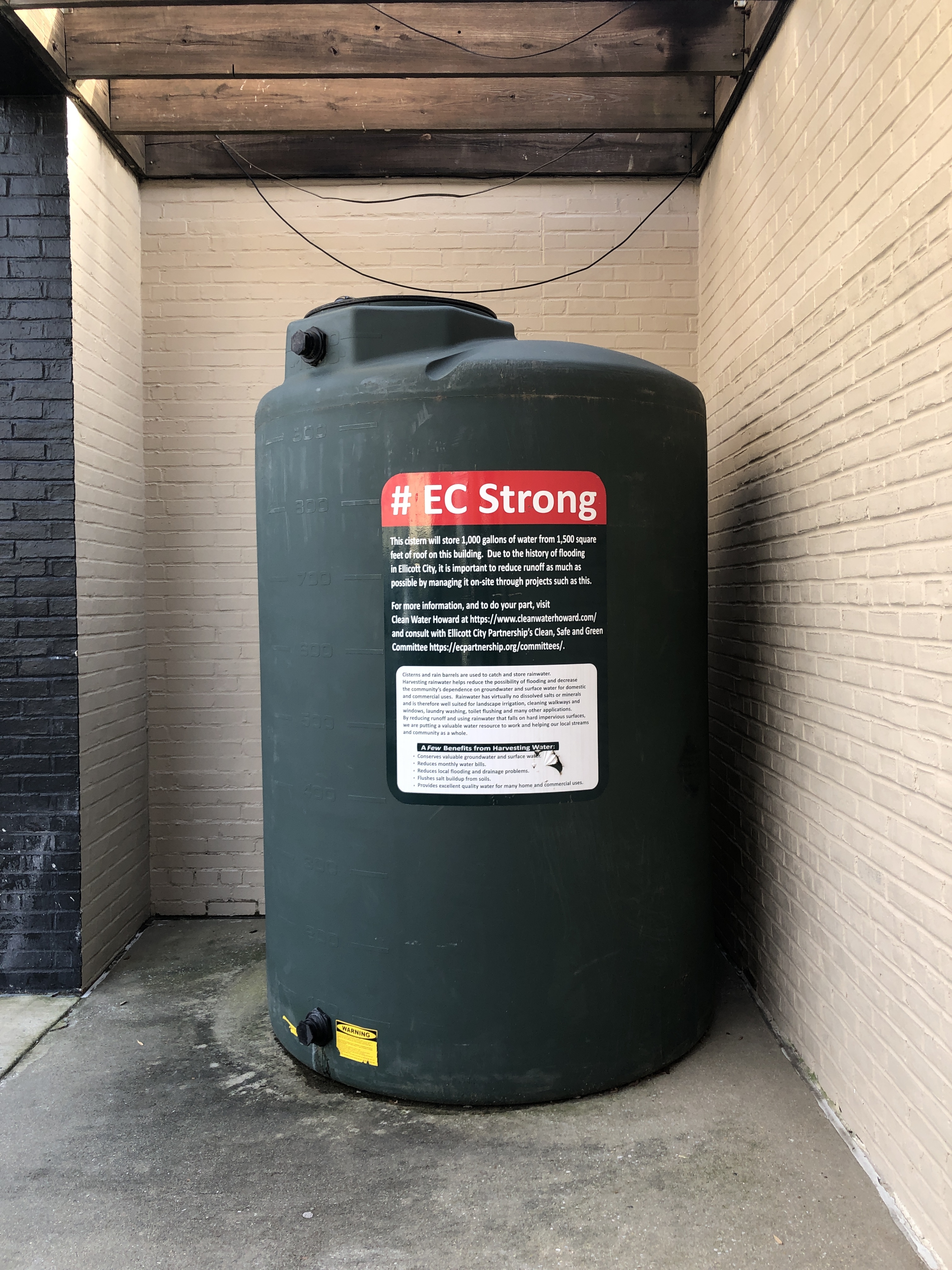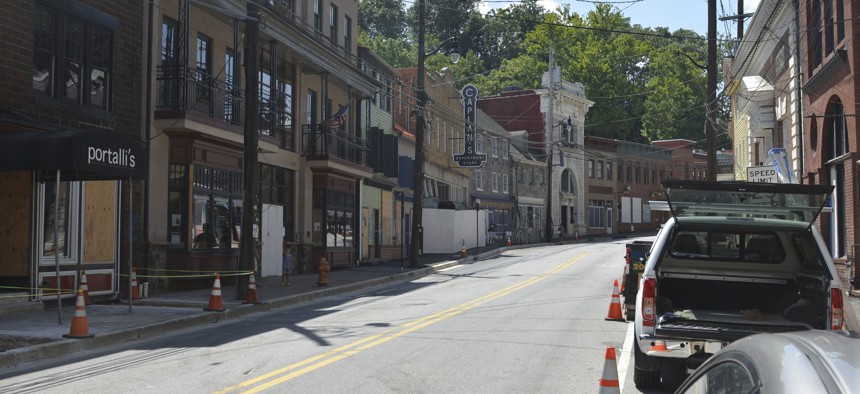Connecting state and local government leaders
After two historic floods in less than two years, officials in Ellicott City, Maryland, are putting their hopes in a long-term rebuilding plan that officials say aims to balance recovery and resiliency with historic preservation.
Since 2011, the historic mill town of Ellicott City has experienced three major floods, the most recent two the result of “thousand-year storms” that occurred less than two years apart.
In July 2016, an estimated 6 inches of rain fell in two hours, resulting in torrents of water that cascaded down the hill that cuts through the downtown area of the Maryland town, tossing cars and debris into storm drains and culverts and killing at least two people. Then, in May 2018, 8 inches of rain dropped in two hours, submerging buildings and streets and killing a National Guardsman. No one had expected the first storm, officials said, but a second less than two years later was unfathomable.
Now, Howard County officials are moving forward with an ambitious, expensive plan to try to protect the historic downtown area from future storms everybody acknowledges will come, while preserving its character and improving resiliency.
The plan seems comprehensive, residents say. But after the trauma of two large-scale disasters and the still-ongoing process of rebuilding, many people in Ellicott City are impatient for faster progress.
"The upside of this plan is that it does feel longer-term and it does feel like more of a solution. I am very pleased that they did a really thorough look at the problems,” said Heather Gaetano, an Ellicott City resident and a vice president of the Ellicott City Partnership, an economic growth and preservation nonprofit. “But I wish that it could come to fruition sooner. That’s the downside.”
County officials say they are acutely aware of this impatience. It makes sense, Howard County Executive Calvin Ball said, given the very real trauma experienced by the town as a whole. But there has been progress made, he noted, including the removal of more than 10 tons of debris from the watershed and the implementation of a new storm warning system. Staff are working on a daily basis to continue that momentum, he said.
“There are no projects we’re working on that aren’t going to impact the flood mitigation plan,” Ball said. “We can’t have every project done as fast as we want. We can’t even start every project as quickly as we want. But we are making progress as quickly as humanly possible.”

A New Reality
After the 2016 storm, many residents thought of it as a freak event, unlikely to be repeated, said Shaina Hernandez, Ball’s senior advisor for policy. “People pushed forward, they rebuilt quickly, and there was a lot of enthusiasm in the town because no one thought it was likely to happen again soon. And then when it happened again, that’s when, really, I think the fear set in—that this is a new reality, and it could happen anytime.”
Ellicott City encompasses three zip codes and stretches into the western part of Howard County, but is best known for its downtown area—winding streets lined with shops and restaurants, all housed in historic buildings along the base of a long hill. The city sits in what’s sometimes referred to as a “granite bowl,” where multiple waterways converge and flow into the Patapsco River—a necessity to run the mills that operated there in the mid-1700s.

Following the 2016 flood, long-term recovery plans, including flood mitigation efforts, remained largely in the planning stages. Then-County Executive Allan Kittleman had unveiled a plan to purchase and raze 10 buildings on the historic stretch of lower Main Street, transforming Ellicott City’s most flood-prone area into a waterfront park. Residents were initially stunned at the prospect, Gaetano said, but had largely come around to the idea by the time Kittleman was unseated by Ball last November.
“It’s safe to say that it took awhile, but the majority of the actual business and property owners in the historic district did come to embrace that plan,” she said. “We have lots of historic preservation folks, myself included, that love our old buildings. A giant part of what makes Ellicott City so special is our historic nature and the buildings there. Nobody wanted 10 buildings knocked down, but we wanted a fix. We believed that plan was fast, and I would say everybody’s primary goal, above everything else, was fixing it quickly.”
When Ball took office at the end of 2018, he promised to come up with a proposal that better balanced resiliency and recovery with preservation of the town’s historic assets. He began by revisiting more than 70 hydrological models that county staff had devised previously, each showing the impacts that individual projects—dozens of them—would have on flood conditions similar to the ones in the town’s two most recent disasters. Ball and his staff then devised five potential long-term recovery plans and presented those to the public in April. The county took public comments, considered residents’ questions and input, and, in May, selected a final plan to put in motion.
That proposal—the "Ellicott City Safe & Sound" plan—is a mix of small and large projects that work together to achieve the broader goal of increasing the town’s resiliency in the face of future storms. Some, like clearing debris from waterways more frequently and identifying high-ground access points, are already underway. Others, like razing four buildings and constructing a tunnel to divert water from buildings on Main Street, are still in the planning stages. The plan was largely well received, particularly by members of the historic preservation community, who had objected strongly to Kittleman’s proposed demolition of 10 buildings.
“This plan is a lot more reasonable,” said Nicholas Redding, executive director of Preservation Maryland, a Baltimore-based nonprofit. “It greatly reduces the number of demolitions, and it’s more selective. The hallmark of a good plan, like this, is that no one is 100 percent happy. If it were up to us we’d save all the structures, but we recognize and understand that this is a good compromise.”
All told, the plan could cost up to $140 million to implement, almost three times more than Kittleman's $50 million original proposal, though county staff said those estimates are purposely on the high end and actual costs are likely to be lower. The county allocated $20.3 million in the current fiscal year for flood mitigation projects in Ellicott City, secured about $7.85 million in state funding for various projects and, so far, has applied for an additional $13.8 million from a mix of state and federal sources, according to budget documents presented to residents in November.
But the rest of the funding remains unclear, and will likely continue to come from a patchwork of sources. Pursuing those funding streams could turn out to be tricky, local leaders acknowledged, particularly when state and federal officials are conditioned to think of flooding as mainly a coastal problem rather than an increasing issue for inland cities as climate change intensifies.
“I think there are a lot of elected officials that aren’t thinking of inland storms, they’re thinking primarily about coastal events,” said Mark DeLuca, deputy director of the Howard County Department of Public Works. “It’s an uphill battle for us, sometimes, even to talk to people in the different agencies just to try to secure money.”
Securing funding from multiple sources requires officials to continue the sense of energy and urgency about Ellicott City. That’s helped somewhat by the county’s strategy of tackling multiple projects over several years, Ball said, and by the fact that the threat of flooding will only increase—in Ellicott City, but also in other inland communities—as temperatures warm due to climate change.
“Sustainable success is built upon the foundation of small successes,” Ball said. “As we continue to open new businesses, as we continue to have our enhanced stream debris removal, as we have constant communication and listening to our residents and stakeholders about how we’re making progress...we’re going to continue to build momentum. My hope is that our success can serve as a model that can be shared throughout our nation, our world, and throughout history.”

Managing Expectations
If funding stays on the track, county staff expect the bulk of the project’s work to be completed by 2024. Some things are already done, including the placement of signage that directs visitors on Main Street to higher ground, and a partnership with landowners that allows people to access private property to quickly evacuate in the event of a flood.
Officials with the county’s emergency management department worked with the National Weather Service to devise an updated warning system that specifically designates whether severe weather is likely to impact historic Ellicott City as opposed to the broader city area. Construction is slated to begin on two retention ponds in the next year, and the county hopes to secure a design firm for the north tunnel by the end of this year. Permits have been filed with the U.S. Army Corps of Engineers to remove sections of some buildings over the stream channel, with a public hearing expected in February.
But much of that work isn’t immediately visible to residents, and some remain impatient for more tangible signs of progress. Ball has fielded questions about what the county would do if another flood struck before all of the projects completed. Staff members think about this possibility, DeLuca said, but can only continue to chip away at the work ahead of them while encouraging residents to take their own precautions ahead of the next big storm.
“You can’t really chase the storm. There is a probability that whatever you do, there’s going to be some chance that a storm will locate in one place and you’ll still have flooding,” he said. “That’s the first limitation that you have to come to grips with, and I think for a technical person to do that, it’s understood, but for someone who is emotionally invested in the town with their business, and they’ve mortgaged their house and they have loans, they want to be assured that flooding will never happen. And I think what we have to say to these people is that it’s the combination. You have to floodproof your building. You just have to.”

Even if the entire plan is funded and completed on time, it will not eliminate flooding in the lower downtown area, DeLuca said. Under conditions like those in the 2016 storm, the fully implemented plan would reduce water levels on Main Street to 3 feet, a depth the Army Corps of Engineers said would minimize damage with proper floodproofing measures. The county offered grants to encourage residents to undertake that work, and hopes to begin a second round of applications in the near future. Many of those measures are simple—removing carpet, relocating HVAC systems to roofs, replacing doors and windows with floodproof models—but they are crucial, DeLuca said.
“All of these things, all together, improve the resiliency of that lower end where they experienced all the standing water,” he said. “It’s a comprehensive plan. It’s not just the tunnel that’s going to save them. They should be doing all of those things.”
The question of resident responsibility is a tricky one, Redding said. People may not have understood the reality of Ellicott City’s topography when they chose to live there, and development in the upper watershed may have exacerbated the area’s tendency to flood, which he said calls into question how much property owners should be required to do to mitigate its effects.
“Just like in any situation, there’s always going to be a component of personal responsibility and a recognition that you’ve bought into a place where there are these risks associated with it. But also at the same time you have to ask the question, how much of this is the result of overdevelopment in the watershed and an unwillingness to slow down or curtail that growth?” he said. “When you start thinking about that, part of me wonders how much personal responsibility is there, when the county and previous administrations are responsible for what we’re seeing here?”
A report commissioned by Howard County after the 2016 flood found that downtown would be susceptible to flooding even if the surrounding areas were entirely undeveloped, though it did stress that development can make stormwater runoff worse.
All of that development, DeLuca added, happened over decades, under shifting regulations that would not be acceptable today.
“If we were building now, none of that would be constructed, because you don’t build in the 100-year floodplain, for this reason,” he said. “This didn’t just happen last year. We’re dealing with that legacy as part of the technical problem, too. We’re not going to rip all that out and we’re not going to rip all of Main Street out. We’re trying to find a solution that works best.”
The Ball administration did address development in the recovery plan, submitting to the Howard County Council two resolutions that require developers to meet higher standards for stormwater management as well as pay higher fees when the land they've purchased can't accommodate stormwater facilities.
Specifically, the resolutions require that developments have the capability to manage "short duration, high-intensity storms," the county said in a news release. If there are "no viable options to adequate manage stormwater on-site," developers will have to pay $175,000 per acre-foot of water storage, more than double the previous rate of $72,000.
The council passed both resolutions at its Oct. 7 meeting, voting 4-1 on the management proposal and 3-2 on the updated fees. Councilwoman Liz Walsh, the only lawmaker to vote no on both proposals, had submitted a competing bill that would have enacted a host of other regulations, including a requirement that new development in the watershed be able to control no less than the peak flood conditions from 2016. The bill, which failed 3-2, would have also done away entirely with "fees in lieu," which are the money that developers pay instead of complying with conservation requirements within the watershed.
Walsh called her measure's failure a "profound disappointment." Its aim, she said, was to "just enforce the laws that we have and make those moderately better. Apparently, that was too big a bite."
Walsh did not return requests for comment.
In a statement following the Oct. 7 meeting, Ball thanked the council for approving the resolutions and did not address Walsh's bill.
"These resolutions will ensure that developers are building the infrastructure necessary to manage the rainfall from increasingly severe weather," he said.
Signs of Recovery
Amid the rebuilding and the long-term planning, there are other signs of recovery in the town. Since December, 18 new businesses and eight existing businesses have opened, or reopened, in historic Ellicott City. The Ellicott City Partnership has turned its attention to the holiday season, planning a host of events to entice tourists and residents to visit downtown in the coming months. There is, Gaetano said, a simultaneous sense of exhaustion and enthusiasm among residents, who are weary from repeatedly sharing their flood stories but optimistic about the future of the city.
“It’s hard for us to talk about the floods, because we want to talk about the 26 businesses that have opened and the cool stuff that’s coming for the holidays,” she said. “We do so much fun happy stuff, and we want the world to know about that, too.”
Kate Elizabeth Queram is a Staff Correspondent for Route Fifty and is based in Washington, D.C.

NEXT STORY: Invasive Grasses are Fueling Wildfires Across the U.S.



